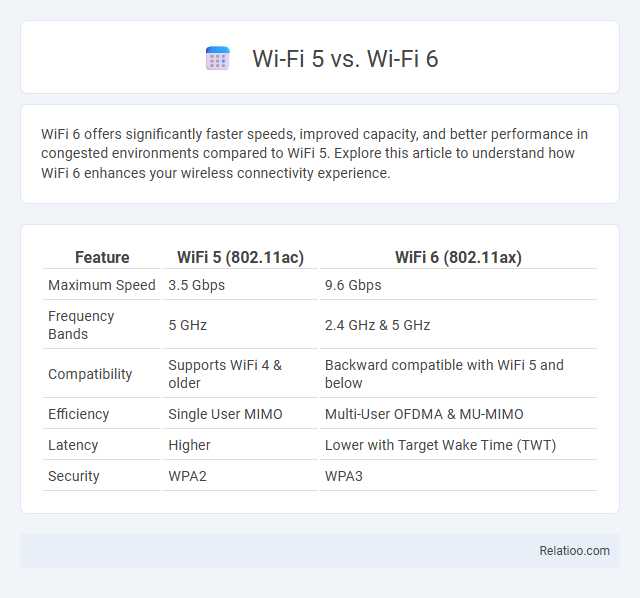WiFi 6 offers significantly faster speeds, improved capacity, and better performance in congested environments compared to WiFi 5. Explore this article to understand how WiFi 6 enhances your wireless connectivity experience.
Table of Comparison
| Feature | WiFi 5 (802.11ac) | WiFi 6 (802.11ax) |
|---|---|---|
| Maximum Speed | 3.5 Gbps | 9.6 Gbps |
| Frequency Bands | 5 GHz | 2.4 GHz & 5 GHz |
| Compatibility | Supports WiFi 4 & older | Backward compatible with WiFi 5 and below |
| Efficiency | Single User MIMO | Multi-User OFDMA & MU-MIMO |
| Latency | Higher | Lower with Target Wake Time (TWT) |
| Security | WPA2 | WPA3 |
Introduction to WiFi 5 and WiFi 6
WiFi 5 operates on the 5 GHz frequency band, offering faster speeds and reduced interference compared to previous standards, while WiFi 6 enhances these capabilities with improved efficiency, higher throughput, and better performance in crowded networks by utilizing both 2.4 GHz and 5 GHz frequencies. Your network experiences significant improvements in latency and capacity with WiFi 6, making it ideal for multiple connected devices and bandwidth-intensive applications. Understanding the frequency differences helps optimize your wireless setup for speed, range, and reliability.
Key Differences Between WiFi 5 and WiFi 6
WiFi 6 offers improved speed, capacity, and efficiency over WiFi 5 by utilizing OFDMA and MU-MIMO technologies, enabling better performance in crowded networks. While WiFi 5 operates primarily on the 5 GHz frequency band, WiFi 6 supports both 2.4 GHz and 5 GHz bands, providing greater flexibility and range. Understanding these key differences helps you optimize your network for faster connections and reduced latency.
Speed and Performance Comparison
WiFi 6 outperforms WiFi 5 by delivering up to 9.6 Gbps compared to WiFi 5's maximum of 3.5 Gbps, thanks to advanced technologies like OFDMA and MU-MIMO that improve efficiency and reduce latency. WiFi 5 primarily operates on the 5 GHz frequency band, offering faster speeds but shorter range, whereas WiFi 6 also supports the 2.4 GHz band, enhancing coverage and device compatibility. The newer WiFi 6 standard excels in dense environments with multiple connected devices, providing faster aggregate speeds and more stable performance than WiFi 5.
Network Capacity and Efficiency
WiFi 6 offers significantly higher network capacity and efficiency compared to WiFi 5 by utilizing OFDMA and MU-MIMO technologies, enabling simultaneous data transmission to multiple devices. The 2.4 GHz and 5 GHz frequency bands in WiFi 6 provide improved performance and reduced congestion, especially in crowded environments. Enhanced modulation schemes like 1024-QAM in WiFi 6 increase throughput and optimize bandwidth use, leading to more efficient network management.
Coverage and Range Advancements
WiFi 6 offers significant improvements over WiFi 5 in terms of coverage and range due to enhanced OFDMA and MU-MIMO technologies, which increase network efficiency and reduce congestion in crowded environments. Operating on both 2.4 GHz and 5 GHz bands, WiFi 6 improves signal penetration and extends range, especially on the 2.4 GHz frequency that provides better coverage through walls and obstacles. Your experience benefits from these advancements with stronger, more reliable connections and broader coverage in larger spaces.
Device Connectivity: MU-MIMO and OFDMA
WiFi 6 significantly improves device connectivity over WiFi 5 by integrating MU-MIMO and OFDMA technologies, enabling simultaneous data transmission to multiple devices and reducing latency. WiFi 5 supports MU-MIMO but only for downstream data, limiting efficiency when multiple devices are connected. Operating primarily on 5 GHz frequency bands, WiFi 6's enhanced spectral efficiency with OFDMA allows better utilization of both 2.4 GHz and 5 GHz frequencies, optimizing performance in dense environments.
Security Improvements in WiFi 6
WiFi 6 enhances security compared to WiFi 5 by introducing WPA3 encryption, which provides stronger data protection and better resistance to brute-force attacks. Operating on both 2.4 GHz and 5 GHz frequency bands, WiFi 6 improves network efficiency and reduces congestion with OFDMA and MU-MIMO technologies. These advancements collectively strengthen encryption protocols and increase the overall security resilience of wireless networks.
Backward Compatibility Considerations
WiFi 6 offers significant improvements in speed, capacity, and efficiency over WiFi 5 while maintaining backward compatibility with older devices operating on 2.4 GHz and 5 GHz frequency bands. Your WiFi 6 router can seamlessly support WiFi 5 and even WiFi 4 devices, ensuring all your connected gadgets work without disruption. Understanding these frequency and compatibility aspects helps optimize network performance and future-proofs your wireless setup.
Real-World Use Cases for WiFi 5 vs WiFi 6
WiFi 6 offers faster speeds, reduced latency, and better performance in crowded environments compared to WiFi 5, making it ideal for homes with multiple smart devices and high-bandwidth activities like 4K streaming or online gaming. WiFi 5, operating primarily on the 5 GHz frequency, provides sufficient reliability and speed for simpler setups with fewer connected devices. Your choice between WiFi 5 and WiFi 6 should consider the frequency bands supported by your router and devices, balancing range, interference, and network density in real-world use cases.
Choosing the Right WiFi Standard for Your Needs
Choosing the right WiFi standard depends on your usage environment and device compatibility, with WiFi 6 offering improved speed, capacity, and reduced latency compared to WiFi 5. WiFi 5 operates solely on the 5 GHz frequency, providing faster speeds but shorter range, while WiFi 6 supports both 2.4 GHz and 5 GHz bands, enhancing coverage and device connectivity. Understanding your network's frequency requirements and device density will help optimize your WiFi performance and ensure your wireless needs are fully met.

Infographic: WiFi 5 vs WiFi 6
 relatioo.com
relatioo.com